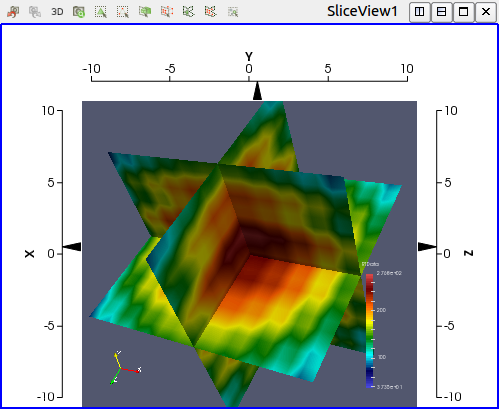


This page summarizes the design details of what ParaView calls the Slice View (sometimes called the Multi-Slice View since it allows the users to add multiple slices).
Let's start by getting an overview of the new classes added for supporting this Slice view.
vtkSMMultiSliceViewProxy is the view-proxy. It's a vtkSMRenderViewProxy subclass. This makes it possible for the application to treat this as simply a specialization of the Render View, which it indeed is. Thus all toolbars for setting axis of rotation, camera positions, selection etc. will continue to work.
pqMultiSliceView is the pqRenderView subclass created by the GUI whenever it encounters a vtkSMMultiSliceViewProxy. The extra thing that this class does it manage the UI components to allow the user to interactively place slices in the view. Use pqMultiSliceAxisWidget, this class updates the XSlicesValues, YSlicesValues, and ZSlicesValues properties on the vtkSMMultiSliceViewProxy proxy.
vtkPVMultiSliceView is a VTK-object controlled by the vtkSMMultiSliceViewProxy. vtkPVMultiSliceView is a indeed a vtkPVRenderView subclass. It adds API to set/get the slice positions along each of the coordinate axes. Representations that want to respect the slices specified by this view can access the view in vtkPVView::REQUEST_UPDATE() pass to get the slice positions. This pass will indeed be triggered on all data-server ranks after the slice positions have been changed.
vtkGeometrySliceRepresentation is a vtkGeometryRepresentation subclass which is used to add a new Slices representation type to the standard GeometryRepresentation proxy. vtkSMMultiSliceViewProxy::GetRepresentationType() will suggest creating of this extended GeometryRepresentation, know as (representations, CompositeMultiSliceRepresentation) to the ProxyManager.
CompositeMultiSliceRepresentation supports the usual representation-types e.g. Surface, Wireframe, etc. along with the new Slices type. Whenever the user picks the Slices representation-type, the vtkGeometrySliceRepresentation will be used.
vtkGeometrySliceRepresentation works with vtkPVMultiSliceView to display any dataset as a set of slices along the coordinate planes. The slice positions are obtained from vtkPVMultiSliceView in the vtkPVView::REQUEST_UPDATE().
vtkGeometrySliceRepresentation works by replacing the vtkPVGeometryFilter (in vtkGeometryRepresentation) with an internal vtkPVGeometryFilter subclass that extracts the slices from the input dataset before passing it to the vtkPVGeometryFilter implementation. It uses the vtkThreeSliceFilter to apply a collection of slice filters in one go.
Let's look at how we support a bunch of miscellaneous use-cases.
Use-Case: When user shows a new dataset in this Slice view, we want the default representation-type to be "Slices", and not "Surface" or anything that vtkSMRepresentationTypeDomain picks.
Solution (HACK): vtkSMMultiSliceViewProxy::CreateDefaultRepresentation() changes the Representation property's value to Slices. Further more, to avoid vtkSMParaViewPipelineController::PostInitializeProxy() from resetting the property value to domain-defaults (using vtkSMProperty::ResetToDomainDefaults()), we add an XML hint to the property. This is done in vtkSMMultiSliceViewProxy::ForceRepresentationType().
Use-Case: When a new dataset is shown in this view, we want the view to automatically place slices at the center of the dataset.
Solution (HACK): We set the properties on the view in vtkSMMultiSliceViewProxy::CreateDefaultRepresentation(). Currently the properties on the view are changed only when there are no slices specified already.
This page is generated from MultiSliceView.md.
 1.8.13 on Thu Mar 28 2024
1.8.13 on Thu Mar 28 2024